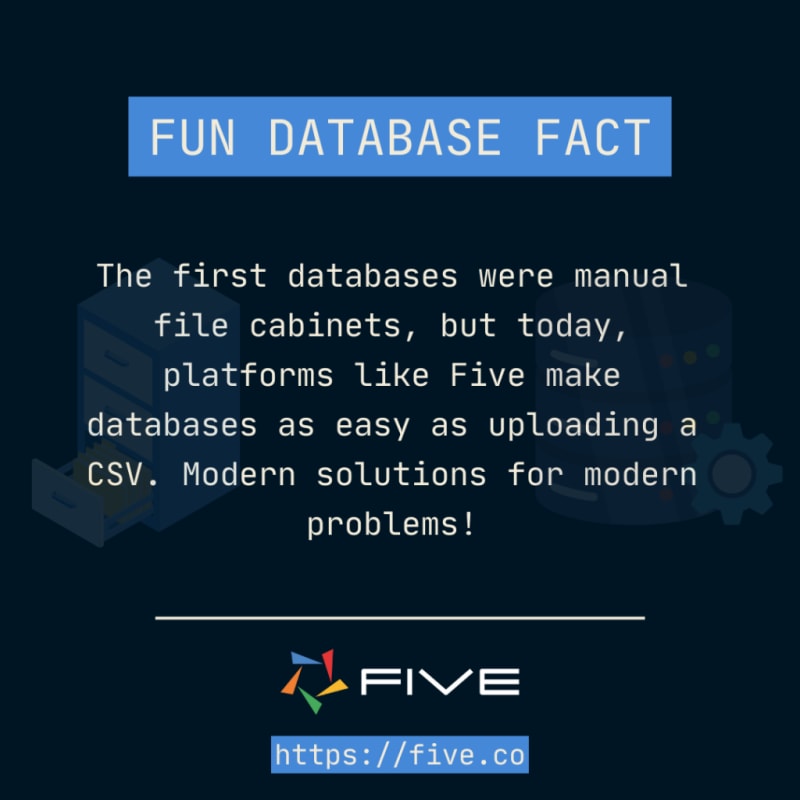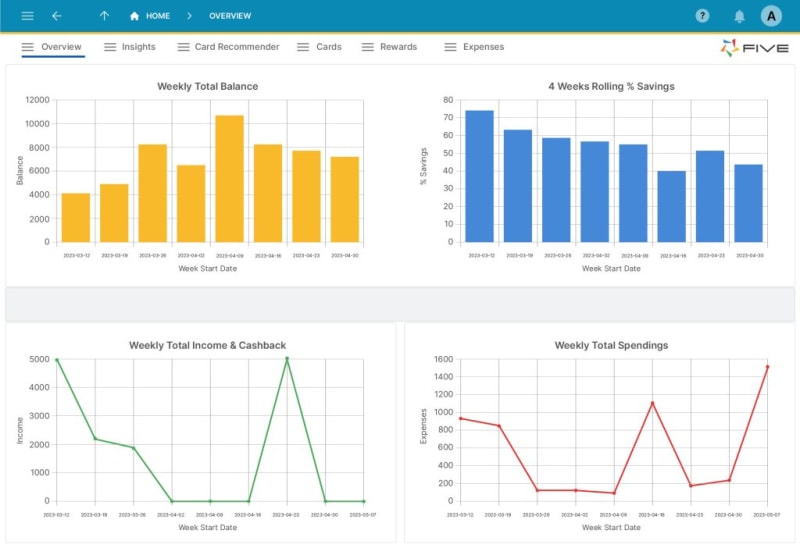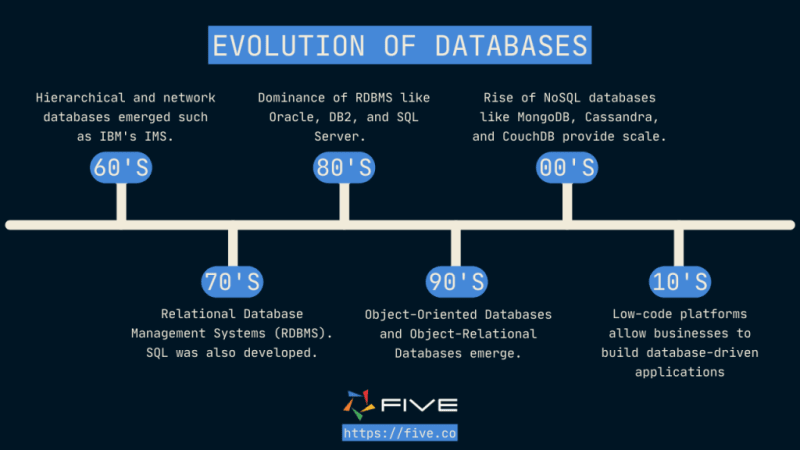How You Can Transform Raw Data in Actionable Insights With Modern Database Management
Databases play a pivotal role for businesses, serving as the backbone of countless applications, websites, and internal processes. As the world continues to generate vast amounts of data, the efficient organization, storage, and retrieval of this data becomes crucial. This is where modern database management comes into play, offering a structured way to store, manage, and access vast reservoirs of information.
- The Evolution of Database Management Systems (DBMS)
- Modern Database Management Simplified
-
Different Kinds of Database Systems
-
Modern Database Management with Five Pt.1
- Modern Database Management with Five Pt.2
- Conclusion
The Evolution of Database Management Systems (DBMS)
Database Management Systems (DBMS) have undergone significant transformations in recent times. What began as rudimentary systems to catalog and retrieve data have now evolved into sophisticated platforms that underpin a vast array of business operations.
In the early days, data was often stored in flat files or hierarchical databases, which had a set structure and required significant manual effort for data retrieval. But as organizations grew and data volumes surged, there emerged a need for more efficient ways to store and access data.
This led to the development of the relational model in the 1970s, a watershed moment in the history of databases. Systems based on this model, known as Relational Database Management Systems (RDBMS), revolutionized data storage and retrieval by representing data in tables, allowing for more versatile and efficient querying.
The turn of the century brought with it the challenges of handling the Internet's explosion and the vast amounts of unstructured data it generated. Modern database systems began to diversify, incorporating NoSQL databases to cater to needs that traditional RDBMS couldn't address. Today, we have a plethora of database systems, each tailored for specific use cases - from object-oriented databases, graph databases, to distributed systems, and more.
Modern Database Management Simplified
Modern DBMS Features: Think of these systems as toolkits. They've got a bunch of features built to handle today's data challenges, making sure everything runs smoothly, safely, and is user-friendly.
- Data Operations: DBMS tools let you play with data. You can create, read, update, or delete data i.e. perform CRUD operations. They provide enhanced querying capabilities, meaning you can dig deep and mold your data just the way you want it.
- Integrity: It's like a promise that your data will stay correct and trustworthy. Modern systems have rules in place (like making sure no two items have the same ID) to stop mistakes or mix-ups.
- Concurrency: Imagine many people trying to edit a document at once. Without control, it's chaos. Modern DBMS ensures everyone can work at the same time, without stepping on each other's toes.
- Backups: With more data, there's more to lose. Modern systems have your back, making sure there are copies of your data. If something goes wrong, you can bring back your lost data. Plus, a lot of this can be set up to run on its own.
- Smart Organization (Normalization): Instead of lumping all data together, modern systems sort data into tables, reducing repeated info. It's like having a well-organized office space – everything has its place, making it efficient and tidy.
In short, modern DBMS tools, are designed to make handling large amounts of data a breeze, ensuring everything is organized, safe, and easily accessible.
Different Kinds of Database Systems
Different applications have unique needs. That's why there's a variety of Database Management Systems (DBMS) to choose from. Here's a quick look at some of the main types:
1. Distributed DBMS:
- What it is: Manages databases across multiple locations. All these databases work together, appearing as one to the user.
- Why it's great: It's scalable. As companies grow, they can add more databases easily.
2. Hierarchical & Network DBMS:
- Hierarchical: Think of it like a company org chart, with a tree structure. Each data point has one "parent" but can have many "children."
- Network: It's a bit more complex. Each child data point can have several parents. It's flexible and mirrors real-life data relationships.
3. Relational DBMS (RDBMS):
- What it is: This popular system organizes data into tables. Each table has rows (records) and columns (attributes).
- Why it's great: It's user-friendly, versatile, and scales well. It's the go-to for many projects, big or small. This is what our low-code IDE Five uses.
4. Object-oriented DBMS:
- What it is: Designed for object-oriented programming, it keeps data as "objects," combining data and related methods.
- Why it's great: Represents real-world entities efficiently. Great for modern, dynamic apps.
To wrap up this section, the variety of DBMS types shows how data management keeps evolving to meet our needs. Whatever your project demands, there's a DBMS out there for you.
| Type | Description | Advantages | Example Use Cases |
|---|---|---|---|
| Distributed DBMS | Manages databases across multiple locations, appearing unified to users. | Highly scalable; can easily expand as companies grow. | E-commerce platforms operating in multiple countries. |
| Hierarchical DBMS | Data structured like an org chart; tree structure with parent-child relationships. | Organized; allows for clear hierarchical data representation. | Organizational directories; file management systems. |
| Network DBMS | Each child data point can have multiple parents; mirrors complex data relationships. | Highly flexible; represents multifaceted data relationships. | Telecommunications networks; airline reservation systems. |
| Relational DBMS (RDBMS) | Organizes data into tables with rows and columns. Used by "Five". | User-friendly, versatile, and scales well. | Customer relationship management (CRM) systems; inventory databases. |
| Object-oriented DBMS | Combines data and related methods as "objects". | Efficient representation of real-world entities; good for dynamic apps. | Graphic design software; video game settings and characters. |

Modern Database Management with Five Pt.1
In an era where businesses rely heavily on data, modern database management has become paramount. Five exemplifies how this evolution is taking place, making database and application creation easier, more flexible, and accessible.
1. Rapid Development and Deployment
In modern database management, speed and flexibility are vital. Five empowers developers to rapidly build custom business applications with the speed of low-code and the depth of full code. This means you can prototype, test, and deploy quicker than ever.

2. Device-Independent Database Applications
The future is mobile. Applications created with Five are web-based and responsive, ensuring accessibility across all devices. No need for multiple codebases; one application fits all.
3. Transform Legacy Systems
Modernizing outdated applications is a significant aspect of contemporary database management. With Five, developers can transition from older systems like Microsoft Access or Excel-based processes into robust, scalable cloud-native web applications.
4. Seamless Integration of Business Logic
Businesses have intricate processes. While many platforms offer out-of-the-box solutions, Five understands that customization is key. With event-driven programming, SQL, and JavaScript, developers can readily tailor solutions to fit specific business logic.
5. Advanced Database Features
As part of modern database management, Five offers features like a GUI for MySQL, visual query building, and easy data importing from CSVs. This ensures developers can manage data efficiently and effectively, all within a unified environment.
IDEs like Five are setting the benchmark by offering a suite of tools that cater to both the developers' needs and the end-users' expectations, all while prioritizing speed, flexibility, security, and user experience. As businesses continue to grow and adapt, the value of such tools in modern database management cannot be understated.
"Five lets you store your database plus gives you the tools to understand it better."
Modern Database Management with Five Pt.2
Data is often touted as the new oil – a vast reservoir of potential waiting to be tapped. Yet, unlike crude oil, raw data isn't inherently valuable. Its true value emerges when it's refined, analyzed, and translated into actionable insights.
Modern Database Management is no longer just about storing and retrieving data but also about making sense of it. To this end, most modern DBMS are equipped with robust tools or integrations tailored for data analytics and reporting.
Five stands out in this context, not just as a DBMS, but as a holistic platform designed to change the way businesses interact with data.
Rapidly Develop Your Data Analysis Tool with Five
Empower Decision-Making With Five: At the core of Five is the understanding that businesses need more than just data – they need insights. Five allows you to build a custom-built Data Analysis Tool that simplifies the complex world of data analytics.

- Intuitive Data Visualization Dashboards: Dive deep into your data with interactive dashboards that are as informative as they are visually compelling. Whether you're looking to track sales metrics, monitor user engagement, or identify emerging market trends, Five has got you covered. These dashboards are not just static displays but dynamic tools that allow for real-time data interaction.
- Customizable Reporting: Every business is unique, and so are its data needs. Five offers customizable reporting tools, enabling businesses to focus on metrics that matter most to them. From pie charts to bar graphs, choose the best way to represent and interpret your data.
- Seamless Integration: Data often resides in different places. Whether it's sales data from an eCommerce platform or user metrics from a mobile app, Five ensures that all your data sources speak the same language. This seamless integration ensures that your analytics and reports are comprehensive.
Conclusion
The digital revolution has ushered in a new age for database management. As we trace back the lineage of Database Management Systems (DBMS), we see a transition from simplistic systems to today's sophisticated platforms. Early methods of storing data, although foundational, were limited in scope. The advent of the Relational Database Management Systems (RDBMS) in the 1970s was a pivotal moment, introducing a structured approach using tables.
Today's landscape showcases a rich variety of DBMS tailored for distinct needs, whether it's the globally-connected Distributed DBMS, the structured Relational DBMS, or the modern Object-oriented DBMS. Among these modern solutions, Five stands out with a suite of advanced features for detailed data management.
In summary, the importance of efficient and effective database management platforms cannot be understated. Tools like "Five" are at the forefront, ensuring that businesses are equipped to handle, interpret, and leverage their data in the most optimal way.




Top comments (0)